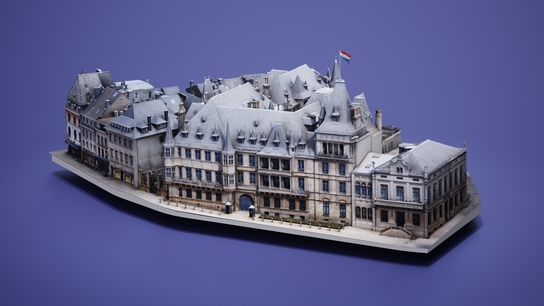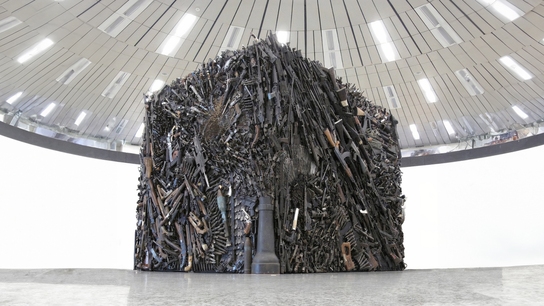Digitizing the historic Notre Dame Basilica to showcase Ray II’s construction potential
Challenge: Digitizing a massive cathedral located in a busy area of Montreal, Canada, in high detail, without including any inquisitive passers-by in the final 3D model.
Solution: Artec Ray II, Artec Studio
Result: An incredibly large, ultra-realistic 3D model of the entire area around the Notre Dame Basilica featuring sufficient detail for heritage preservation or potential exploration in VR.
Why Artec 3D?: Artec Ray II rapidly, accurately captures large areas or objects, with its visual inertial system (VIS) allowing it to track positioning, so it knows where it’s located in a 3D space. Artec Studio software then makes it easy to combine scans captured from different positions, or use additional 3D scan or photogrammetry data to boost detail in critical areas.

The Notre Dame Basilica in Montreal, Canada. Image used under the Creative Commons license
No stroll around downtown Montreal is complete without going to see its famous Notre Dame Basilica. Often ranked amongst the city’s most popular tourist sights, this imposing neo-Gothic church is not just an impressive piece of architecture, it’s a time capsule for local history.
Built in 1656, 14 years after Montreal itself was founded, the cathedral features paintings and stained glass windows of key figures from across its storied past. This includes religious leaders like Marguerite Bourgeoys, as well as the city’s founder Paul Chomedey de Maisonneuve.
As you’d expect, the Notre Dame Basilica has become a treasured landmark in Montreal’s bustling streets, and it continues to bring a valuable historic flavor to a now-modern city. But like many heritage sites, the Basilica needs constant maintenance. Restoration work on its exterior facade, including its stonework, flashings, and bell towers, has been underway since 2020.
With the world’s monuments starting to look increasingly fragile, many are turning to 3D scanning for digital heritage preservation. However, capturing an entire area or structure can be a lot more difficult than it sounds. Popular tourist attractions are usually covered with people, hiding buildings from the view of 3D scanners and other data capture devices alike. They also tend to be absolutely massive, requiring an ultra-fast, powerful digitization solution.

Artec Ray II 3D scanning the Basilica’s exterior. Image courtesy of Solidxperts
Enter, Artec Gold-certified Partner Solidxperts. When its team first got their hands on the all-new Artec Ray II, they sought to demonstrate its building capture potential – and the Notre Dame Basilica seemed the perfect test case. Digitizing the city’s most famous landmark would preserve it for future generations, while showcasing Ray II’s large-scale capture proficiency.
Capturing the jewel in Canada’s crown
When the Solidxpert team showed up on-site to scan the Basilica, their main challenges were environment and scale. As expected, the area was swarming with people. It was also massive, in a way that could’ve taken days to capture in the freezing cold of a Canadian winter.
Instead, Ray II made capture fast, simple, and intuitive. The device’s built-in display allows it to be set up without a laptop and operated remotely via the Artec Remote app. In this case, the team scanned from around 25 locations, picking up different angles of the cathedral as they went. Here, Ray II’s VIS system proved pivotal to 3D space navigation – and helped ensure that none of the site’s defining characteristics went uncaptured.

Solidxperts’ 3D scan inside Artec Studio. Image courtesy of Solidxperts
Also home to a statue of Montreal’s founder, the area around the Basilica is filled with objects of interest. To ensure all this was captured as well, they positioned Ray II in a circle around this monument, picking up all the data needed at a speed of up to 2 million pts/sec. After just a few hours, they had compiled a complete dataset, and the team were delighted with the results.
“Our scans are incredible,” said Alexandre Gosselin, director of AM and 3D scanning at Solidxperts. “One of the buildings captured is about 30 stories tall and has a glass exterior (making it very difficult to scan). Okay, some of the windows didn’t come out perfectly, but you can see the entire Basilica and even the surrounding streets. We captured these objects from over 100 meters away. Ray II’s range is nuts when you think about it!”

Artec Ray II 3D scanning the statue of Montreal’s founder. Image courtesy of Solidxperts
Creating an immersive 3D model
Data processing began in Artec Studio, where Solidxperts tidied up, aligned, and fused captured scans into a detailed 3D mesh. Ray II’s ‘double-scanning’ algorithm effectively removed moving objects like passers-by. Along with the device’s wireless nature and long-life battery, Gosselin says this made clean data capture incredibly easy. But the software’s outlier removal and eraser tools still came in handy for applying polish without having to export to third-party software.
The resulting model turned out so lifelike, Solidxperts’ team believe they could one day use the same approach to create a 3D model with sufficient depth for VR applications. To capture this additional detail, they’d use Artec Studio’s multi-resolution fusion feature to combine 3D scan datasets, or AI Photogrammetry to upscale results using images/videos captured by drone.
“I do have access to a drone, but there are heavy restrictions in Montreal concerning drone flights, airways around the city, so I’d have to verify if it’s possible,” added Gosselin. “We could also have scanned some parts of the statue with Leo for better detail capture, then imported these scans alongside Ray II data in the same dataset. Together, Leo & Ray II capture more data in a very, very fast manner – I see huge potential for them in this area.”

The final 3D model of Montreal’s founder in Artec Studio. Image courtesy of Solidxperts
Addressing growing demand
Artec 3D scanning has already become a hugely popular means of preserving heritage sites around the world. Through its network of trusted partners, Artec 3D’s technologies have digitized everything from landmarks in its native Luxembourg to ancient relics for a Discovery Channel documentary, immortalizing these movements as realistic 3D models each time.
Many of these have been digitized using a combination of Artec handheld, LiDAR, and photogrammetry 3D data capture. Now, Solidxperts are seeing increasing demand for these solutions in the broader architecture and construction industries, where complete detail capture is an absolute necessity for effective site planning, analysis, and retrofitting.
“Currently, many of our Ray II leads are in construction,” concluded Gosselin. “One very clear application we have right now is a customer looking to build a platform for a machinery site. So there’s piping, there’s other small items, machinery all around. Our goal is to scan the whole environment, all the pipes, all the wires, all the equipment as they are. Then you can just import this into SolidWorks and make this structure based on scan data alone.”
With their Basilica scan, the Solidxperts team have done more than just digitize part of historic Montreal, they’ve opened up a world of possibilities. Digitization at scale has never been so simple, it’ll be exciting to see what kind of infrastructure – old or new – they’re tasked with scanning next.
Scanners behind the story
Try out the world's leading handheld 3D scanners.





